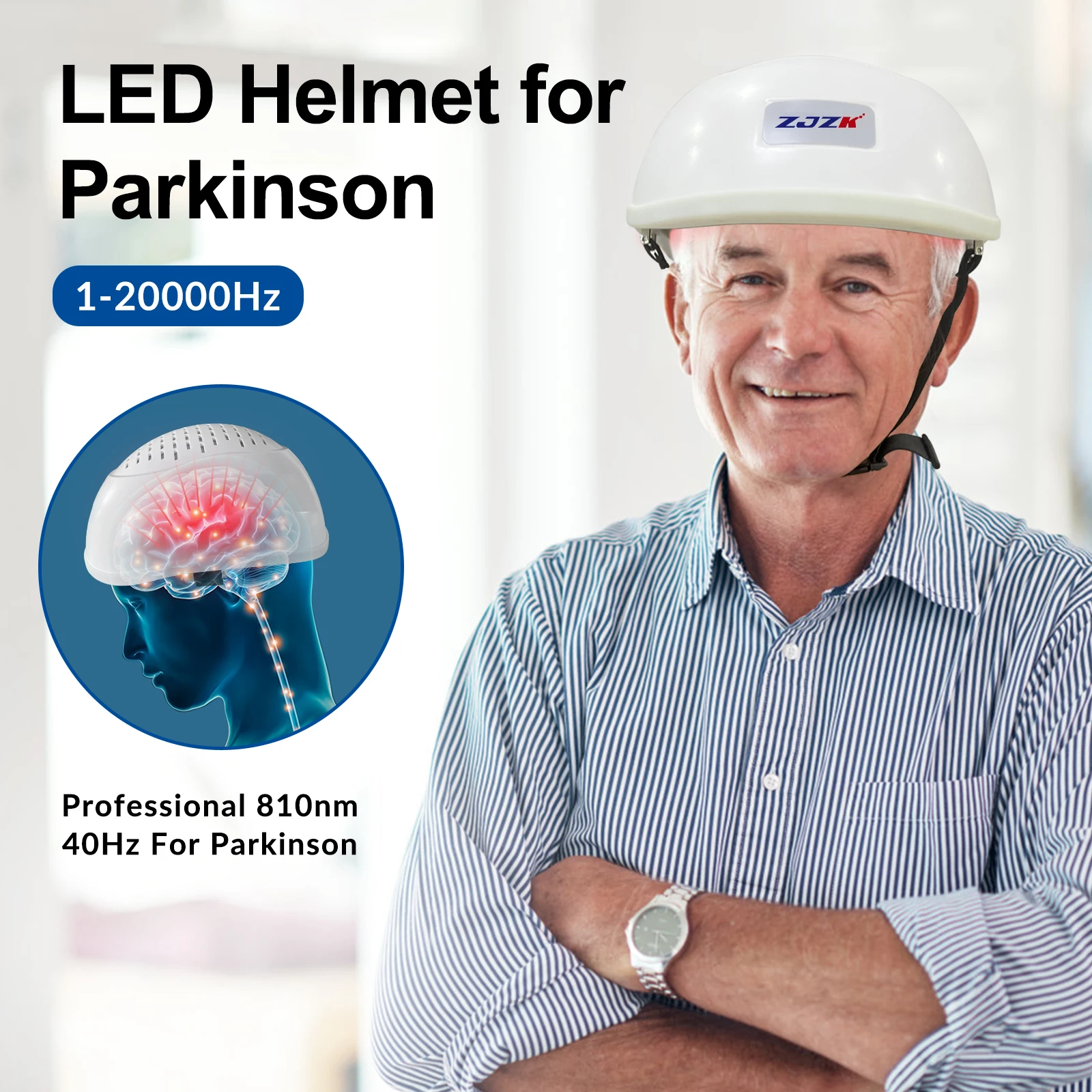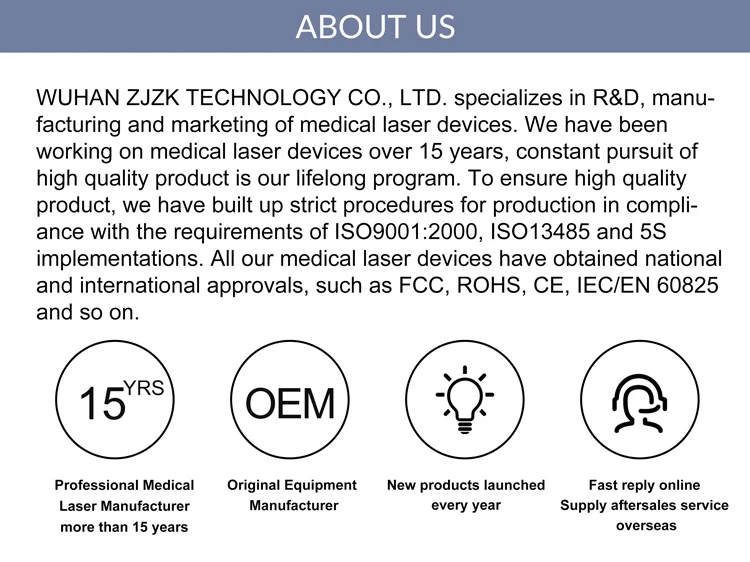
Photobiomodulation of the brain with 810nmLEDs helmet
Brain photobiomodulation (PBM) with red (near infrared) LEDs (LED), innovative therapy for various neurological and psychological disorders, stimulate mitochondrial respiratory complex, increase ATP synthesis, improve the metabolic ability of neurons and can stimulate anti-inflammatory, anti-apoptotic and antioxidant reactions as well as neurogenesis and synaptogenesis. The results suggest that the PBM can improve the functions of the frontal brain of older people in a safe and cost-effective manner. The equipment is based on the use of an infrared LED with a wavelength of 810 nm .



ZJZK Photobiomodulation Helmet For Different Brain Disorders
Brain is one of the most important organ system of human body and the most necessary to life, Also the most worried by humankind. The brain suffers from many different disorders that can be classified into three broad groupings: traumatic events (stroke, traumatic brain injury, and global ischemia), degenerative diseases (dementia, Alzheimer's and Parkinson's), and psychiatric disorders (depression, anxiety, post traumatic stress disorder). Photobiomodulation (PBM) describes the use of red or near-infrared light to stimulate, heal, regenerate, and protect brain tissue that has either been injured, is degenerating, or else is at risk of dying.

How does the ZJZK Helmet works ?
It applies infrared led lights extend through skull, penetrate deep into brain tissue, increase ATP production and blood oxygen to the brain tissue,boost the brain activities, improve memory and enhance cognition.
The magic treatment effect lies in the Cytochrome C oxidase , short of CCO. It is a specific structure in mitochondria that act as a photon receptor and thus plays the PBM effect. PBM prevents respiratory inhibition (and correspondingly reduces energy storage) in stress cells by isolating nitric oxide (NO) and reversing the shift of oxygen in cytochrome C oxidase. The binding of nitric oxide (NO) to copper (or heme) centers in the mitochondrial cytochrome C oxidase (CCO) inhibits cell respiration. But cytochrome C oxidase, which absorbs red or near-infrared (NIR) light, dissociates nitric oxide, restoring oxygen, increasing cellular respiration, and forming adenosine triphosphate (ATP). This triggers a cascade of intracellular reactions involving nitric oxide, reactive oxygen species (ROS), and cyclic adenosine phosphate (cAMP) that produce beneficial effects of PBM. In addition, This triggers transcription factors that alter gene expression levels, activate signaling pathways and transcription factors that cause changes in protein expression.

Product Introduction
Photobiomodulation (PBM) describes the use of red or near-infrared light to stimulate, heal, regenerate, and protect tissue that has either been injured, is degenerating, or else is at risk of dying. One of the organ systems of the human body that is most necessary to life, and whose optimum functioning is most worried about by humankind in general, is the brain.
The brain suffers from many different disorders that can be classified into three broad groupings: traumatic events (stroke, traumatic brain injury, and global ischemia), degenerative diseases (dementia, Alzheimer's and Parkinson's), and psychiatric disorders (depression, anxiety, post traumatic stress disorder). There is some evidence that all these seemingly diverse conditions can be beneficially affected by applying light to the head. There is even the possibility that PBM could be used for cognitive enhancement in normal healthy people.
810nm near-infrared light can penetrate the scalp and skull. Transcranial leds from the near infrared spectrum have been shown to provide anti-inflammatory and antioxidant effects.Heat shock proteins can also be added to prevent protein misfolding and unwanted synthesis;Has the potential to increase neuron regeneration and synaptic regeneration.
Working Principle
Cytochrome C oxidase (CCO, also known as complex IV) is a specific structure in mitochondria that ACTS as a photon receptor and thus plays the PBM effect.PBM prevents respiratory inhibition (and correspondingly reduces energy storage) in stress cells by isolating nitric oxide (NO) and reversing the shift of oxygen in cytochrome C oxidase.This triggers transcription factors that alter gene expression levels.The binding of nitric oxide (NO) to copper (or heme) centers in the mitochondrial cytochrome C oxidase (CCO) inhibits cell respiration.But cytochrome C oxidase, which absorbs red or near-infrared (NIR) light, dissociates nitric oxide, restoring oxygen, increasing cellular respiration, and forming adenosine triphosphate (ATP).This triggers a cascade of intracellular reactions involving nitric oxide, reactive oxygen species (ROS), and cyclic adenosine phosphate (cAMP) that produce beneficial effects of PBM.
Function
• Open heat-gated ion channels and modulate the transcription factors
• Improves cytochrome c oxidase function in mitochondria
• Enhance neuroprotective proteins and growth factors
• Increases active oxygen content inside the brain
• Promotes cerebral ATP energy production
• Accelerate intracranial blood flow



Photobiomodulation and wakefulness
In almost all previous reports on the impact of photobiomodulation on body tissues, stretching back nearly seventy years, the treatment has been applied when the experimental animals or human subjects were in the state of wakefulness. These reports have shown many beneficial effects of photobiomodulation, on the functional activity of neurones in health and disease, including the protection of neurones in disease. There have also been many previous studies exploring the photobiomodulation-induced mechanisms that underpin these effects on neuronal function and survival. These issues will be considered, in turn, below.
Photobiomodulation influences functional activity
Most – if not all – of the reports that have examined the functional activity of neurones in the brain after application of photobiomodulation have been from an external, transcranial device. The light issued from such devices has been shown by many previous studies to penetrate, at the very least as far as the cerebral cortex, approximately ten to fifteen millimeters beneath the cranial surface (see Hamblin, 2016; Mitrofanis, 2019). Indeed, transcranial photobiomodulation to normal, healthy humans – both young and older – has been reported to improve high-level cognitive functions, in terms of reaction times or performances to a range of learning and memory retrieval tasks (Barrett and Gonzalez-Lima, 2013; Gonzalez-Lima and Barrett, 2014; Blanco et al., 2017a,b; Grover et al., 2017; Jahan et al., 2019).
In 2017, together with research fellow Cécile Moro, they injected 20 macaques with a neurotoxin known to cause Parkinson's symptoms. In nine of them, they also delivered NIR to the midbrain area through an implanted device. Mitrofanis recalls how the first NIR-treated monkey behaved after a 3-week recovery period: "He was moving around like there was nothing wrong. We looked at each other and just hugged. ... It was euphoric." Overall, NIR-treated monkeys developed fewer symptoms than the untreated group and retained 20% to 60% more of the brain cells targeted by the neurotoxin.













